Development of Biodegradable Composites Using Polycaprolactone and Bamboo Powder
Abstract
:1. Introduction
2. Materials and Methods
2.1. Materials
2.2. Solvent Casting and Compression Moulding
2.3. Morphology
2.4. Degradation
2.4.1. Soil Burial Degradation
2.4.2. Acidic Degradation
2.5. Porosity
2.6. Water Contact Angle Measurement
2.7. Thermal Analysis
2.7.1. Thermogravimetric Analysis
2.7.2. Differential Scanning Calorimetry
2.8. Fourier Transform Infrared Spectroscopy
2.9. Mechanical Properties
2.9.1. Tensile Properties
2.9.2. Flexural Properties
2.10. Hardness Test
2.11. Statistical Analysis
3. Results and Discussion
3.1. Morphology
3.2. Fourier Transform Infrared Spectroscopy
3.3. Porosity
3.4. Water Contact Angle
3.5. Degradation
3.5.1. Acidic Degradation
3.5.2. Soil Burial Degradation
3.6. Mechanical Properties
3.6.1. Tensile Properties
3.6.2. Flexural Properties
3.7. Hardness
3.8. Thermal Properties
3.8.1. Thermogravimetric Analysis
3.8.2. Differential Scanning Calorimetry
4. Conclusions
Author Contributions
Funding
Institutional Review Board Statement
Informed Consent Statement
Data Availability Statement
Acknowledgments
Conflicts of Interest
References
- Goriparthi, B.K.; Suman, K.N.S.; Nalluri, M.R. Processing and characterization of jute fiber reinforced hybrid biocomposites based on polylactide/polycaprolactone blends. Polym. Compos. 2012, 33, 237–244. [Google Scholar] [CrossRef]
- Kakarla, A.B.; Nukala, S.G.; Kong, I. Biodegradable materials. In Materials for Lightweight Constructions; CRC Press: Boca Raton, FL, USA, 2022; pp. 161–190. [Google Scholar]
- Wu, C.-S. Preparation and characterizations of polycaprolactone/green coconut fiber composites. J. Appl. Polym. Sci. 2010, 115, 948–956. [Google Scholar] [CrossRef]
- Jha, K.; Tyagi, Y.K.; Singh Yadav, A. Mechanical and thermal behaviour of biodegradable composites based on polycaprolactone with pine cone particle. Sādhanā 2018, 43, 135. [Google Scholar] [CrossRef] [Green Version]
- Nukala, S.G.; Kong, I.; Kakarla, A.B.; Tshai, K.Y.; Kong, W. Preparation and Characterisation of Wood Polymer Composites Using Sustainable Raw Materials. Polymers 2022, 14, 3183. [Google Scholar] [CrossRef] [PubMed]
- Abdul Khalil, H.P.S.; Bhat, I.U.H.; Jawaid, M.; Zaidon, A.; Hermawan, D.; Hadi, Y.S. Bamboo fibre reinforced biocomposites: A review. Mater. Des. 2012, 42, 353–368. [Google Scholar] [CrossRef]
- Cintra, S.C.; Braga, N.F.; de Melo Morgado, G.F.; do Amaral Montanheiro, T.L.; Marini, J.; Passador, F.R.; Montagna, L.S. Development of new biodegradable composites materials from polycaprolactone and wood flour. Wood Mater. Sci. Eng. 2021, 1–12. [Google Scholar] [CrossRef]
- Chen, Q.; Li, X.; Lin, J. Preparation and properties of biodegradable bamboo powder/ polycaprolactone composites. J. For. Res. 2009, 20, 271–274. [Google Scholar] [CrossRef]
- Labet, M.; Thielemans, W. Synthesis of polycaprolactone: A review. Chem. Soc. Rev. 2009, 38, 3484. [Google Scholar] [CrossRef]
- Bhagabati, P.; Das, D.; Katiyar, V. Bamboo-flour-filled cost-effective poly(ε-caprolactone) biocomposites: A potential contender for flexible cryo-packaging applications. Mater. Adv. 2021, 2, 280–291. [Google Scholar] [CrossRef]
- Si, S.; Tang, Q.; Li, X. The Accelerated Thermo-Oxidative Aging Characteristics of Wood Fiber/Polycaprolactone Composite: Effect of Temperature, Humidity and Time. J. Renew. Mater. 2021, 9, 2209–2222. [Google Scholar] [CrossRef]
- Ilyas, R.A.; Zuhri, M.Y.M.; Norrrahim, M.N.F.; Misenan, M.S.M.; Jenol, M.A.; Samsudin, S.A.; Nurazzi, N.M.; Asyraf, M.R.M.; Supian, A.B.M.; Bangar, S.P.; et al. Natural Fiber-Reinforced Polycaprolactone Green and Hybrid Biocomposites for Various Advanced Applications. Polymers 2022, 14, 182. [Google Scholar] [CrossRef] [PubMed]
- Archer, E.; Torretti, M.; Madbouly, S. Biodegradable polycaprolactone (PCL) based polymer and composites. Phys. Sci. Rev. 2021. [Google Scholar] [CrossRef]
- Karakus, K. Polycaprolactone (PCL) based polymer composites filled wheat straw flour. Kastamonu Üniversitesi Orman Fakültesi Derg. 2016, 16. [Google Scholar] [CrossRef] [Green Version]
- Valdés, A.; Fenollar, O.; Beltrán, A.; Balart, R.; Fortunati, E.; Kenny, J.M.; Garrigós, M.C. Characterization and enzymatic degradation study of poly(ε-caprolactone)-based biocomposites from almond agricultural by-products. Polym. Degrad. Stab. 2016, 132, 181–190. [Google Scholar] [CrossRef] [Green Version]
- Kitagawa, K.; Shimamura, T.; Senba, K.; Okumura, H.; Takasima, S.; Hamaguchi, M.; Nakai, A.; Hamada, H.; Lee, S.H.; Ohkita, T. Development of bamboo fiber-reinforced biodegradable polymer composites. Jpn. Soc. Polym. Process. 2003, 3, 165–166. [Google Scholar]
- Okubo, K.; Fujii, T.; Yamamoto, Y. Development of bamboo-based polymer composites and their mechanical properties. Compos. Part A Appl. Sci. Manuf. 2004, 35, 377–383. [Google Scholar] [CrossRef]
- Radzi, A.M.; Zaki, S.A.; Hassan, M.Z.; Ilyas, R.A.; Jamaludin, K.R.; Daud, M.Y.M.; Aziz, S.A. Bamboo-Fiber-Reinforced Thermoset and Thermoplastic Polymer Composites: A Review of Properties, Fabrication, and Potential Applications. Polymers 2022, 14, 1387. [Google Scholar] [CrossRef]
- Nkeuwa, W.N.; Zhang, J.; Semple, K.E.; Chen, M.; Xia, Y.; Dai, C. Bamboo-based composites: A review on fundamentals and processes of bamboo bonding. Compos. Part B Eng. 2022, 235, 109776. [Google Scholar] [CrossRef]
- Rasheed, M.; Jawaid, M.; Parveez, B.; Hussain Bhat, A.; Alamery, S. Morphology, Structural, Thermal, and Tensile Properties of Bamboo Microcrystalline Cellulose/Poly(Lactic Acid)/Poly(Butylene Succinate) Composites. Polymer 2021, 13, 465. [Google Scholar] [CrossRef]
- Zhao, X.; Jin, Y.; Zhu, X.; Zhu, L. Effect of Bamboo Fiber Mass Fraction on Properties of PCL/PLA/Bamboo Fiber Composites. Plast. Sci. Technol. 2016, 10. [Google Scholar]
- Zhang, Y.-C.; Wu, H.-Y.; Qiu, Y.-P. Morphology and properties of hybrid composites based on polypropylene/polylactic acid blend and bamboo fiber. Bioresour. Technol. 2010, 101, 7944–7950. [Google Scholar] [CrossRef]
- Qi, W.; Taherzadeh, M.J.; Ruan, Y.; Deng, Y.; Chen, J.-S.; Lu, H.-F.; Xu, X.-Y. Denitrification performance and microbial communities of solid-phase denitrifying reactors using poly (butylene succinate)/bamboo powder composite. Bioresour. Technol. 2020, 305, 123033. [Google Scholar] [CrossRef] [PubMed]
- Kieling, A.C.; Santana, G.P.; Dos Santos, M.D.D.M.C.; Neto, J.C.D.M.; Del Pino, G.G.; Dos Santos, M.D.D.M.C.; Duvoisin, S.; Panzera, T.H. Wood-plastic Composite Based on Recycled Polypropylene and Amazonian Tucumã (Astrocaryum aculeatum) Endocarp Waste. Fibers Polym. 2021, 22, 2834–2845. [Google Scholar] [CrossRef]
- Tiwari, S.K.; Umamaheswara Rao, A.; Reddy, N.; Sharma, H.; Pandey, J.K. Synthesis, characterization and finite element analysis of polypropylene composite reinforced by jute and carbon fiber. Mater. Today Proc. 2021. [Google Scholar] [CrossRef]
- Yang, F.; Long, H.; Xie, B.; Zhou, W.; Luo, Y.; Zhang, C.; Dong, X. Mechanical and biodegradation properties of bamboo fiber-reinforced starch/polypropylene biodegradable composites. J. Appl. Polym. Sci. 2020, 137, 48694. [Google Scholar] [CrossRef]
- Chee, S.S.; Jawaid, M.; Sultan, M.T.H.; Alothman, O.Y.; Abdullah, L.C. Accelerated weathering and soil burial effects on colour, biodegradability and thermal properties of bamboo/kenaf/epoxy hybrid composites. Polym. Test. 2019, 79, 106054. [Google Scholar] [CrossRef]
- Maran, J.P.; Sivakumar, V.; Thirugnanasambandham, K.; Sridhar, R. Degradation behavior of biocomposites based on cassava starch buried under indoor soil conditions. Carbohydr. Polym. 2014, 101, 20–28. [Google Scholar] [CrossRef]
- Kakarla, A.B.; Kong, I.; Turek, I.; Kong, C.; Irving, H. Printable gelatin, alginate and boron nitride nanotubes hydrogel-based ink for 3D bioprinting and tissue engineering applications. Mater. Des. 2022, 213, 110362. [Google Scholar] [CrossRef]
- Johari, N.; Fathi, M.H.; Golozar, M.A. Fabrication, characterization and evaluation of the mechanical properties of poly (ɛ-caprolactone)/nano-fluoridated hydroxyapatite scaffold for bone tissue engineering. Compos. Part B Eng. 2012, 43, 1671–1675. [Google Scholar] [CrossRef]
- Sdrobiş, A.; Darie, R.N.; Totolin, M.; Cazacu, G.; Vasile, C. Low density polyethylene composites containing cellulose pulp fibers. Compos. Part B Eng. 2012, 43, 1873–1880. [Google Scholar] [CrossRef]
- Wang, P.; Liang, C.; Wu, B.; Huang, N.; Li, J. Protection of copper corrosion by modification of dodecanethiol self-assembled monolayers prepared in aqueous micellar solution. Electrochim. Acta 2010, 55, 878–883. [Google Scholar] [CrossRef]
- Li, Y.-F.; Liu, Y.-X.; Wang, X.-M.; Wu, Q.-L.; Yu, H.-P.; Li, J. Wood-polymer composites prepared by the in situ polymerization of monomers within wood. J. Appl. Polym. Sci. 2011, 119, 3207–3216. [Google Scholar] [CrossRef]
- Prabhakar, M.N.; ur Rehman Shah, A.; Song, J.-I. Improved flame-retardant and tensile properties of thermoplastic starch/flax fabric green composites. Carbohydr. Polym. 2017, 168, 201–211. [Google Scholar] [CrossRef]
- Li, Z.; Wang, L.; Wang, X. Compressive and flexural properties of hemp fiber reinforced concrete. Fibers Polym. 2004, 5, 187–197. [Google Scholar] [CrossRef]
- Li, Z.; Wang, X.; Wang, L. Properties of hemp fibre reinforced concrete composites. Compos. Part A Appl. Sci. Manuf. 2006, 37, 497–505. [Google Scholar] [CrossRef] [Green Version]
- Okonkwo, E.G.; Anabaraonye, C.N.; Daniel-Mkpume, C.C.; Egoigwe, S.V.; Okeke, P.E.; Whyte, F.G.; Okoani, A.O. Mechanical and thermomechanical properties of clay-Bambara nut shell polyester bio-composite. Int. J. Adv. Manuf. Technol. 2020, 108, 2483–2496. [Google Scholar] [CrossRef]
- Nukala, S.G.; Kong, I.; Kakarla, A.B.; Kong, W.; Kong, W. Development of Wood Polymer Composites from Recycled Wood and Plastic Waste: Thermal and Mechanical Properties. J. Compos. Sci. 2022, 6, 194. [Google Scholar] [CrossRef]
- Kakarla, A.B.; Kong, I.; Kong, C.; Irving, H. Extrusion-Based Bioprinted Boron Nitride Nanotubes Reinforced Alginate Scaffolds: Mechanical, Printability and Cell Viability Evaluation. Polymers 2022, 14, 486. [Google Scholar] [CrossRef]
- da Silva, W.A.; Luna, C.B.B.; da Costa Agra de Melo, J.B.; Araújo, E.M.; dos S. Filho, E.A.; Duarte, R.N.C. Feasibility of Manufacturing Disposable Cups using PLA/PCL Composites Reinforced with Wood Powder. J. Polym. Environ. 2021, 29, 2932–2951. [Google Scholar] [CrossRef]
- Shibata, M.; Inoue, Y.; Miyoshi, M. Mechanical properties, morphology, and crystallization behavior of blends of poly(l-lactide) with poly(butylene succinate-co-l-lactate) and poly(butylene succinate). Polymer 2006, 47, 3557–3564. [Google Scholar] [CrossRef]
- Hernández, A.R.; Contreras, O.C.; Acevedo, J.C.; Moreno, L.G.N. Poly (ε-caprolactone) degradation under acidic and alkaline conditions. Am. J. Polym. Sci 2013, 3, 70–75. [Google Scholar]
- Lyu, J.S.; Lee, J.-S.; Han, J. Development of a biodegradable polycaprolactone film incorporated with an antimicrobial agent via an extrusion process. Sci. Rep. 2019, 9, 20236. [Google Scholar] [CrossRef] [PubMed] [Green Version]
- Hoidy, H.W.; Ahmad, B.M.; Almulla, E.; Ibrahim, N.A. Preparation and Characterization of Polylactic Acid/Polycaprolactone Clay Nanocomposites. J. Appl. Sci. 2010, 10, 97–106. [Google Scholar] [CrossRef]
- Hejna, A.; Piszcz-Karaś, K.; Filipowicz, N.; Cieśliński, H.; Namieśnik, J.; Marć, M.; Klein, M.; Formela, K. Structure and performance properties of environmentally-friendly biocomposites based on poly(ɛ-caprolactone) modified with copper slag and shale drill cuttings wastes. Sci. Total Environ. 2018, 640–641, 1320–1331. [Google Scholar] [CrossRef]
- Su, S.-K.; Wu, C.-S. The Processing and Characterization of Polyester/Natural Fiber Composites. Polym. Plast. Technol. Eng. 2010, 49, 1022–1029. [Google Scholar] [CrossRef]
- Liew, F.K.; Hamdan, S.; Rahman, M.R.; Mahmood, M.R.; Lai, J.C.H. The effects of nanoclay and tin(IV) oxide nanopowder on morphological, thermo-mechanical properties of hexamethylene diisocyanate treated jute/bamboo/polyethylene hybrid composites. J. Vinyl Addit. Technol. 2018, 24, 358–366. [Google Scholar] [CrossRef]
- Elzein, T.; Nasser-Eddine, M.; Delaite, C.; Bistac, S.; Dumas, P. FTIR study of polycaprolactone chain organization at interfaces. J. Colloid Interface Sci. 2004, 273, 381–387. [Google Scholar] [CrossRef]
- Vidal, J.L.; Yavitt, B.M.; Wheeler, M.D.; Kolwich, J.L.; Donovan, L.N.; Sit, C.S.; Hatzikiriakos, S.G.; Jalsa, N.K.; MacQuarrie, S.L.; Kerton, F.M. Biochar as a sustainable and renewable additive for the production of Poly(ε-caprolactone) composites. Sustain. Chem. Pharm. 2022, 25, 100586. [Google Scholar] [CrossRef]
- Swain, P.T.R.; Biswas, S. A comparative analysis of physico-mechanical, water absorption, and morphological behaviour of surface modified woven jute fiber composites. Polym. Compos. 2018, 39, 2952–2960. [Google Scholar] [CrossRef]
- Panthapulakkal, S.; Sain, M. Injection-molded short hemp fiber/glass fiber-reinforced polypropylene hybrid composites—Mechanical, water absorption and thermal properties. J. Appl. Polym. Sci. 2007, 103, 2432–2441. [Google Scholar] [CrossRef]
- Büyüksarı, Ü.; Avci, E.; Akkılıç, H. Effect of pine cone ratio on the wettability and surface roughness of particleboard. Bioresources 2014, 5, 1824–1833. [Google Scholar]
- Borysiuk, P.; Wilkowski, J.; Krajewski, K.; Auriga, R.; Skomorucha, A.; Auriga, A. Selected properties of flat-pressed wood-polymer composites for high humidity conditions. BioResources 2020, 15, 5141–5155. [Google Scholar] [CrossRef]
- Allaf, R.M.; Futian, M. Solid-State Compounding for Recycling of Sawdust Waste into Green Packaging Composites. Processes 2020, 8, 1386. [Google Scholar] [CrossRef]
- Wu, C.-S.; Wu, D.-Y.; Wang, S.-S. Preparation and Characterization of Polylactic Acid/Bamboo Fiber Composites. ACS Appl. Bio Mater. 2022, 5, 1038–1046. [Google Scholar] [CrossRef]
- Dinesh, S.; Kumaran, P.; Mohanamurugan, S.; Vijay, R.; Singaravelu, D.L.; Vinod, A.; Sanjay, M.R.; Siengchin, S.; Bhat, K.S. Influence of wood dust fillers on the mechanical, thermal, water absorption and biodegradation characteristics of jute fiber epoxy composites. J. Polym. Res. 2020, 27, 9. [Google Scholar] [CrossRef]
- Schirp, A.; Ibach, R.E.; Pendleton, D.E.; Wolcott, M.P. Biological Degradation of Wood-Plastic Composites (WPC) and Strategies for Improving the Resistance of WPC against Biological Decay. In Development of Commercial Wood Preservatives; American Chemical Society: Washington, DC, USA, 2008; pp. 480–507. [Google Scholar]
- Idicula, M.; Malhotra, S.K.; Joseph, K.; Thomas, S. Dynamic mechanical analysis of randomly oriented intimately mixed short banana/sisal hybrid fibre reinforced polyester composites. Compos. Sci. Technol. 2005, 65, 1077–1087. [Google Scholar] [CrossRef]
- Mohanty, A.K.; Khan, M.A.; Hinrichsen, G. Influence of chemical surface modification on the properties of biodegradable jute fabrics—polyester amide composites. Compos. Part A Appl. Sci. Manuf. 2000, 31, 143–150. [Google Scholar] [CrossRef]
- Sood, A.; Ramarao, S.; Carounanidy, U. Influence of different crosshead speeds on diametral tensile strength of a methacrylate based resin composite: An in-vitro study. J. Conserv. Dent. 2015, 18, 214. [Google Scholar] [CrossRef] [Green Version]
- Krishnaprasad, R.; Veena, N.R.; Maria, H.J.; Rajan, R.; Skrifvars, M.; Joseph, K. Mechanical and Thermal Properties of Bamboo Microfibril Reinforced Polyhydroxybutyrate Biocomposites. J. Polym. Environ. 2009, 17, 109. [Google Scholar] [CrossRef]
- Campaña, O.; Guerrero, V.H. Mechanical and Thermal Characterization of Polylactic Acid (PLA) Reinforced with Bamboo Powder (PB). Rev. Politécnica 2018, 42, 17–24. [Google Scholar]
- Kaymakci, A.; Ayrilmis, N.; Gulec, T. Surface properties and hardness of polypropylene composites filled with sunflower stalk flour. BioResources 2013, 8, 592–602. [Google Scholar] [CrossRef]
- Kord, B. Investigation of reinforcing filler loading on the mechanical properties of wood plastic composites. World Appl. Sci. J. 2011, 13, 171–174. [Google Scholar]
- Kaymakci, A.; Ayrilmis, N. Investigation of correlation between Brinell hardness and tensile strength of wood plastic composites. Compos. Part B Eng. 2014, 58, 582–585. [Google Scholar] [CrossRef]
- Jumadi, M.T.; Mansor, M.R.; Mustafa, Z.; Tokoroyama, T.; Umehara, N. The study on microhardness of natural fibre composite made by recycled material. In Proceedings of the SAKURA Symposium on Mechanical Science and Engineering 2017, Nagoya, Japan, 12 September 2017. [Google Scholar]
- Norizan, M.N.; Abdan, K.; Salit, M.S.; Mohamed, R. Physical, mechanical and thermal properties of sugar palm yarn fibre loading on reinforced unsaturated polyester composites. J. Phys. Sci. 2017, 28. [Google Scholar] [CrossRef] [Green Version]
- Monteiro, S.N.; Calado, V.; Rodriguez, R.J.S.; Margem, F.M. Thermogravimetric behavior of natural fibers reinforced polymer composites—An overview. Mater. Sci. Eng. A 2012, 557, 17–28. [Google Scholar] [CrossRef]
- Kumar, A.; Wang, L.; Dzenis, Y.A.; Jones, D.D.; Hanna, M.A. Thermogravimetric characterization of corn stover as gasification and pyrolysis feedstock. Biomass Bioenergy 2008, 32, 460–467. [Google Scholar] [CrossRef]
- Mansaray, K.G.; Ghaly, A.E. Thermal degradation of rice husks in nitrogen atmosphere. Bioresour. Technol. 1998, 65, 13–20. [Google Scholar] [CrossRef]
- Youssefian, S.; Rahbar, N. Molecular Origin of Strength and Stiffness in Bamboo Fibrils. Sci. Rep. 2015, 5, 11116. [Google Scholar] [CrossRef] [PubMed] [Green Version]
- Kaymakci, A.; Gulec, T.; Hosseinihashemi, S.K.; Ayrilmis, N. Physical, mechanical and thermal properties of wood/zeolite/plastic hybrid composites. Maderas. Cienc. Tecnol. 2017. [Google Scholar] [CrossRef] [Green Version]
- El Mechtali, F.Z.; Essabir, H.; Nekhlaoui, S.; Bensalah, M.O.; Jawaid, M.; Bouhfid, R.; Qaiss, A. Mechanical and thermal properties of polypropylene reinforced with almond shells particles: Impact of chemical treatments. J. Bionic Eng. 2015, 12, 483–494. [Google Scholar] [CrossRef]
- Rojas-Lema, S.; Arevalo, J.; Gomez-Caturla, J.; Garcia-Garcia, D.; Torres-Giner, S. Peroxide-Induced Synthesis of Maleic Anhydride-Grafted Poly(butylene succinate) and Its Compatibilizing Effect on Poly(butylene succinate)/Pistachio Shell Flour Composites. Molecules 2021, 26, 5927. [Google Scholar] [CrossRef] [PubMed]
- Açıkalın, K. Thermogravimetric analysis of walnut shell as pyrolysis feedstock. J. Therm. Anal. Calorim. 2011, 105, 145–150. [Google Scholar] [CrossRef]
- Lei, Y.; Wu, Q.; Yao, F.; Xu, Y. Preparation and properties of recycled HDPE/natural fiber composites. Compos. Part A Appl. Sci. Manuf. 2007, 38, 1664–1674. [Google Scholar] [CrossRef]
- Satapathy, S.; Kothapalli, R.V.S. Mechanical, Dynamic Mechanical and Thermal Properties of Banana Fiber/Recycled High Density Polyethylene Biocomposites Filled with Flyash Cenospheres. J. Polym. Environ. 2018, 26, 200–213. [Google Scholar] [CrossRef]
- Mi, Y.; Chen, X.; Guo, Q. Bamboo fiber-reinforced polypropylene composites: Crystallization and interfacial morphology. J. Appl. Polym. Sci. 1997, 64, 1267–1273. [Google Scholar] [CrossRef]
- Prinos, J.; Bikiaris, D.; Theologidis, S.; Panayiotou, C. Preparation and characterization of LDPE/starch blends containing ethylene/vinyl acetate copolymer as compatibilizer. Polym. Eng. Sci. 1998, 38, 954–964. [Google Scholar] [CrossRef]
- Salazar-Cruz, B.A.; Chávez-Cinco, M.Y.; Morales-Cepeda, A.B.; Ramos-Galván, C.E.; Rivera-Armenta, J.L. Evaluation of Thermal Properties of Composites Prepared from Pistachio Shell Particles Treated Chemically and Polypropylene. Molecules 2022, 27, 426. [Google Scholar] [CrossRef]
- Huang, Y.; Liu, H.; He, P.; Yuan, L.; Xiong, H.; Xu, Y.; Yu, Y. Nonisothermal crystallization kinetics of modified bamboo fiber/PCL composites. J. Appl. Polym. Sci. 2010, 116, 2119–2125. [Google Scholar] [CrossRef]
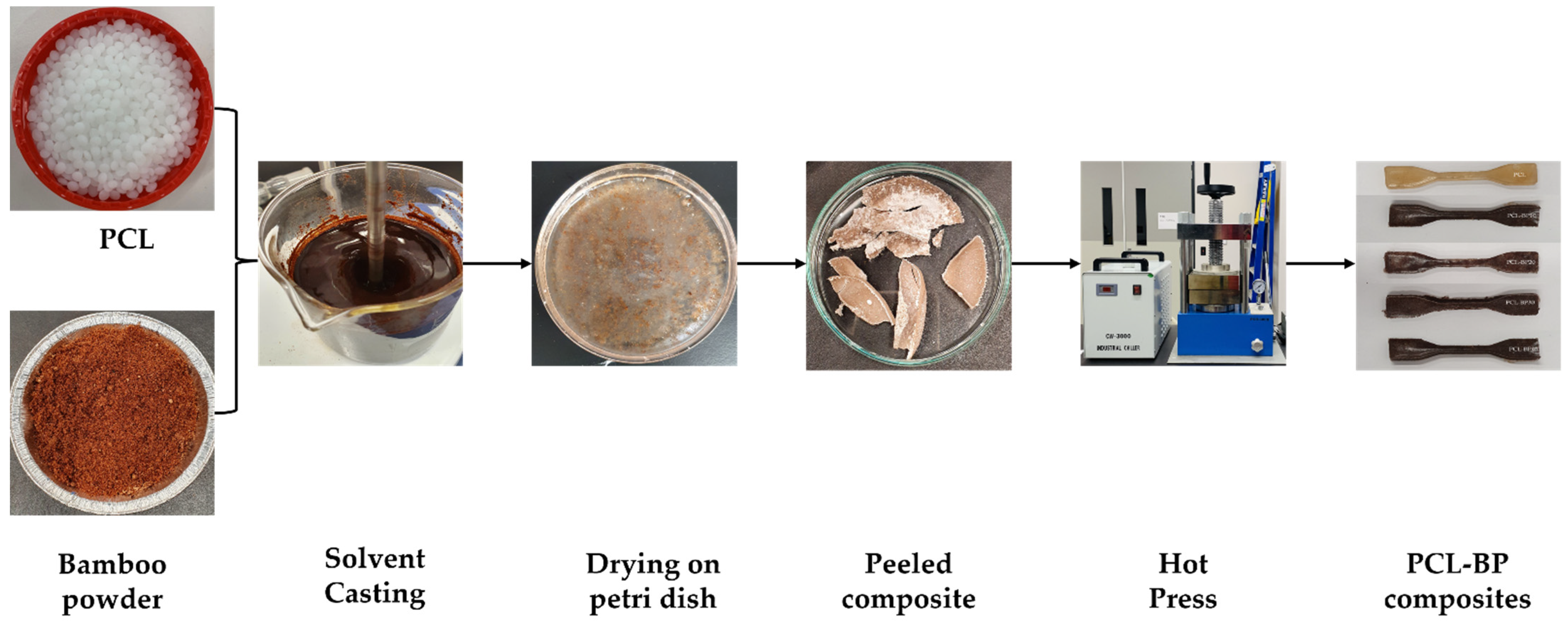

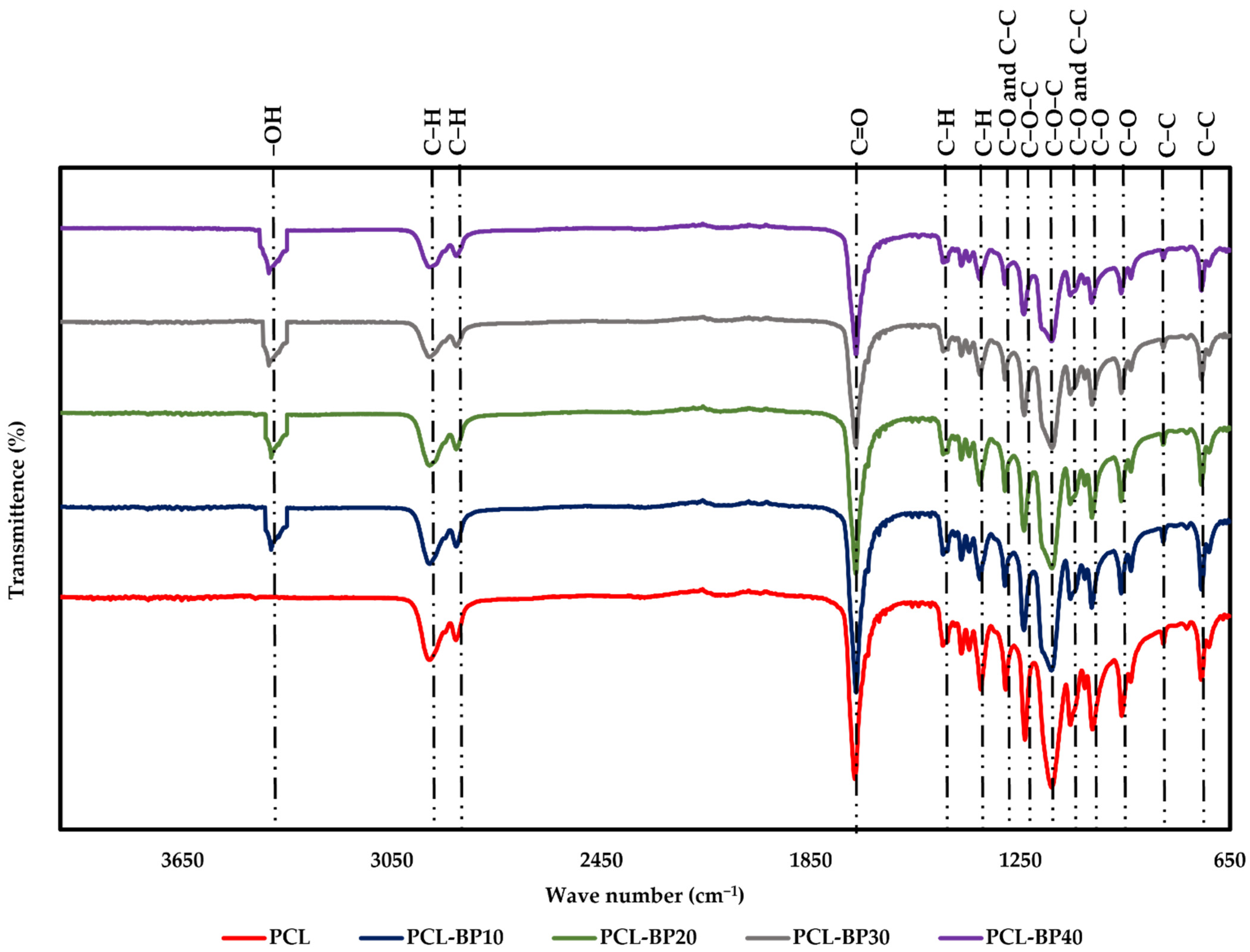
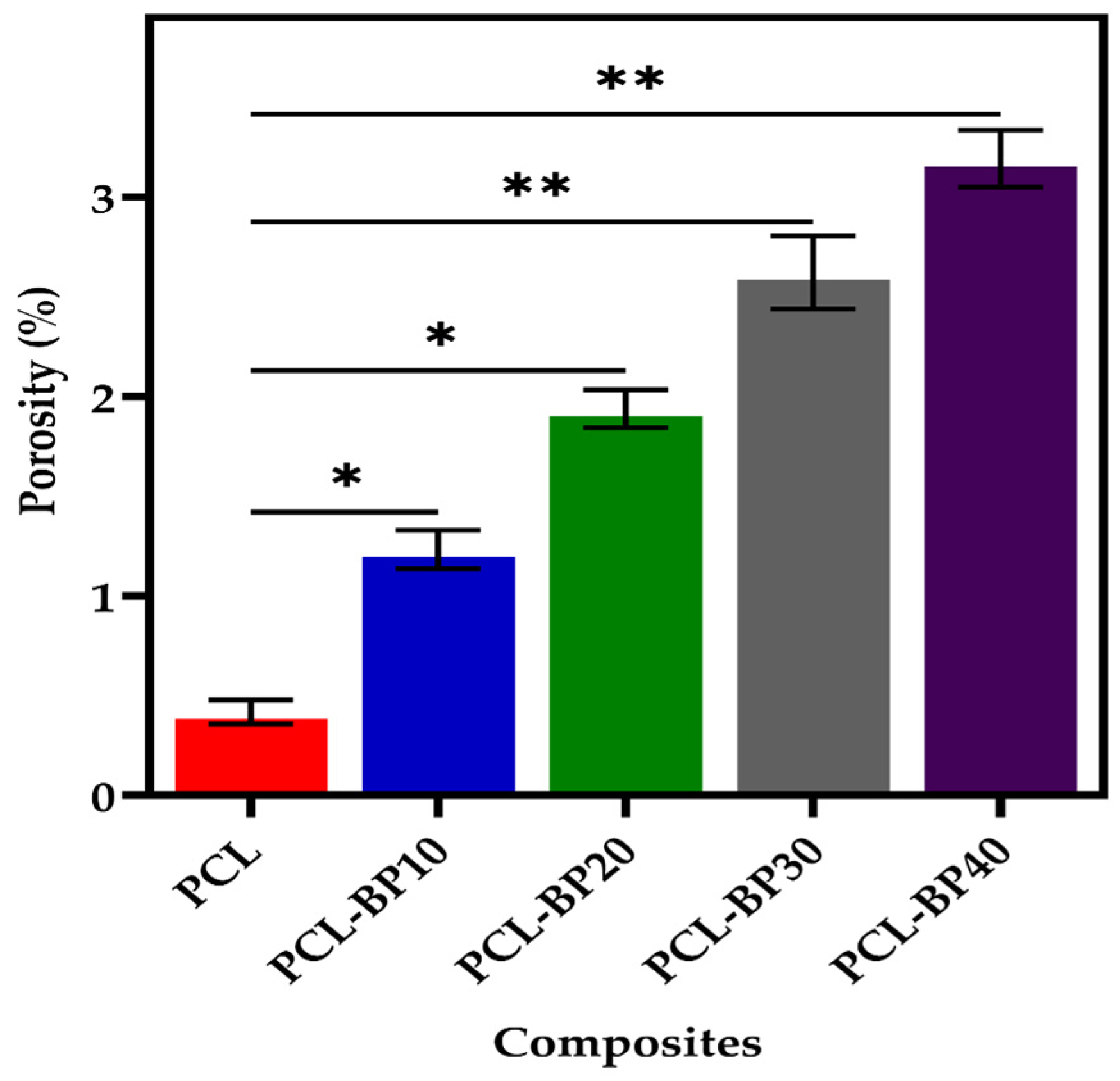
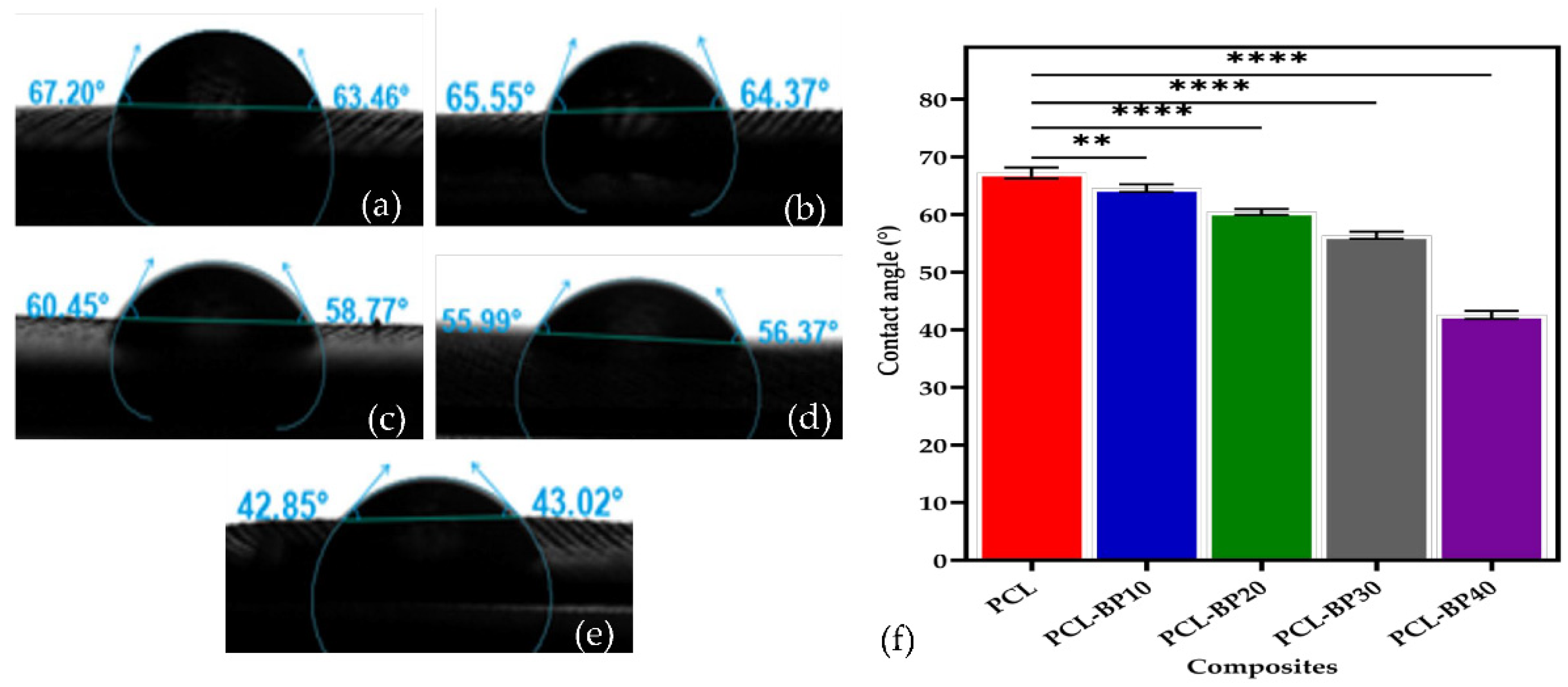



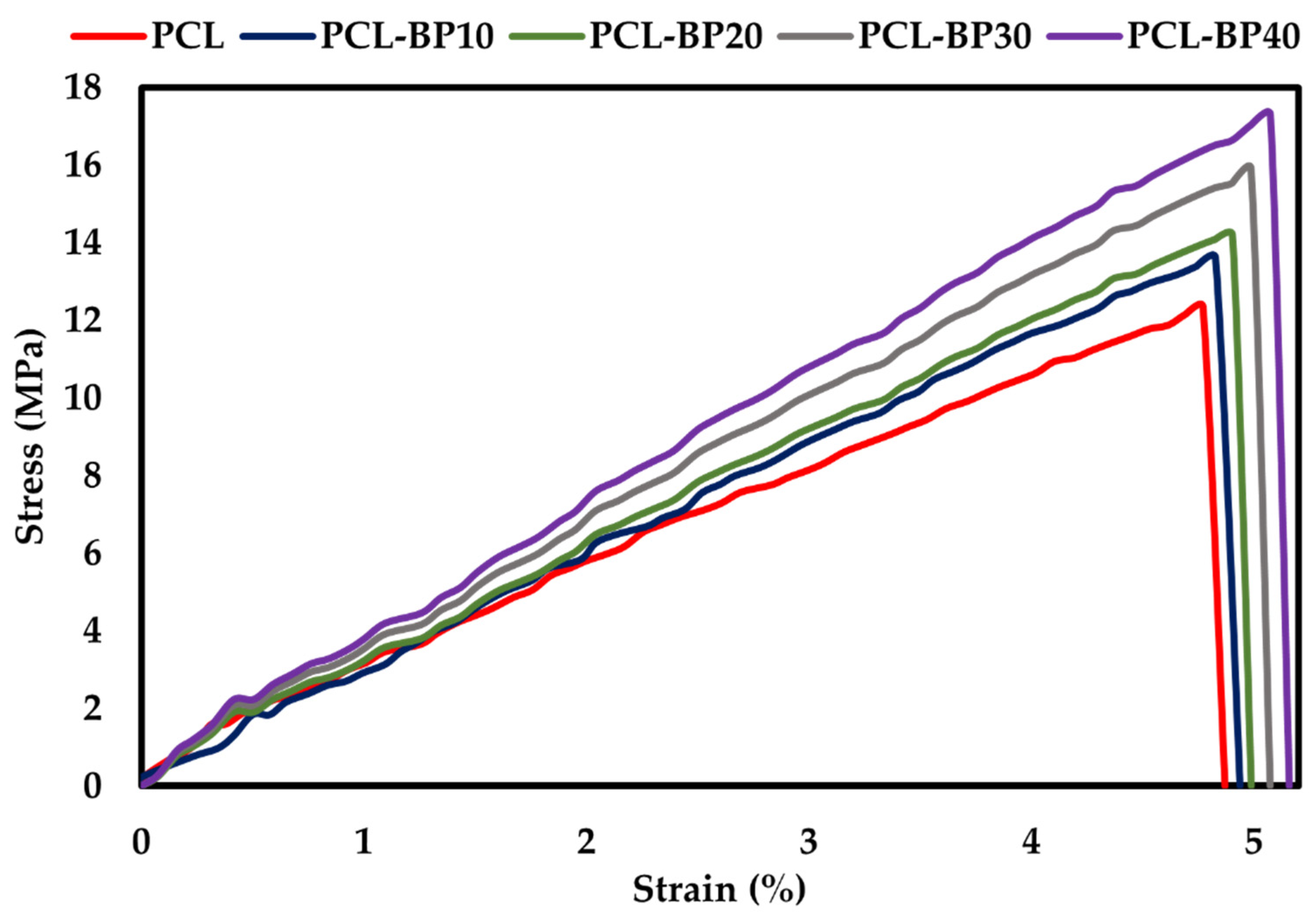
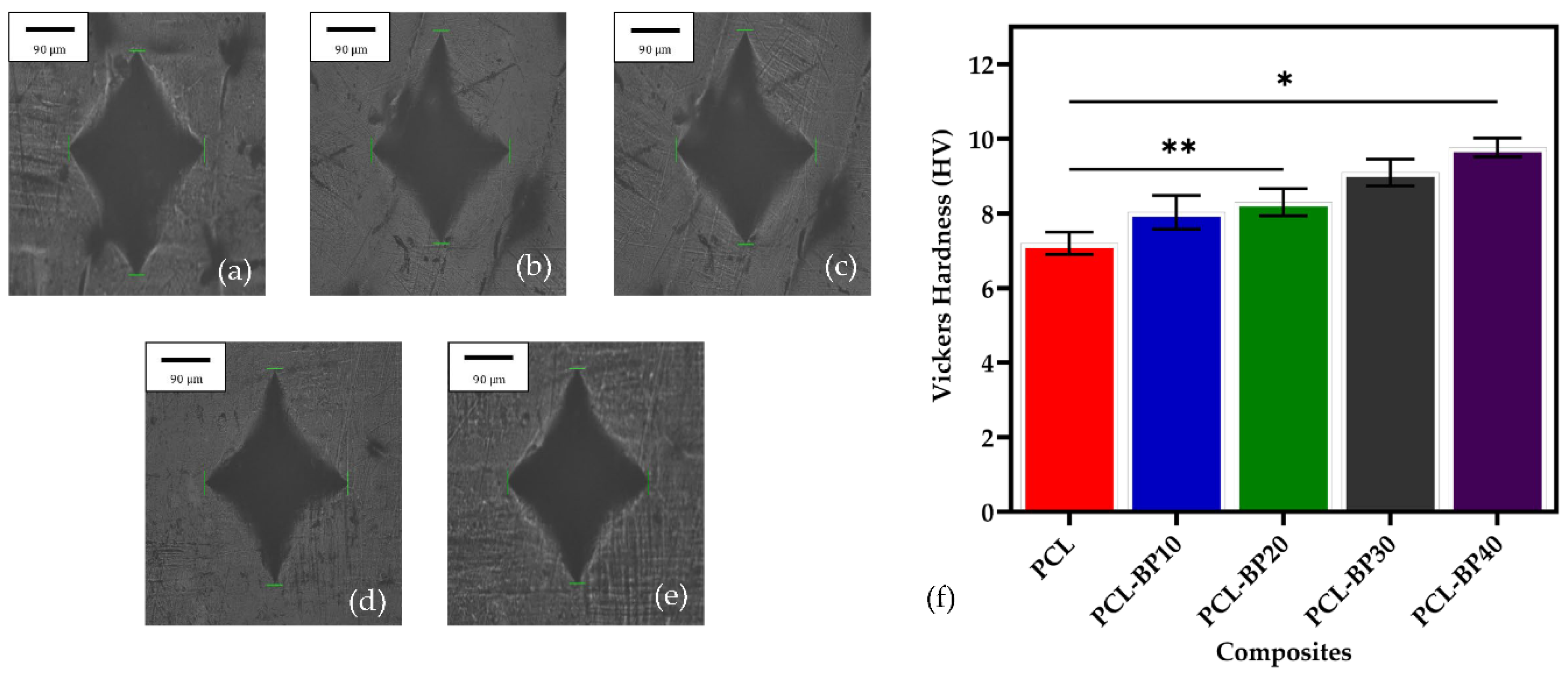
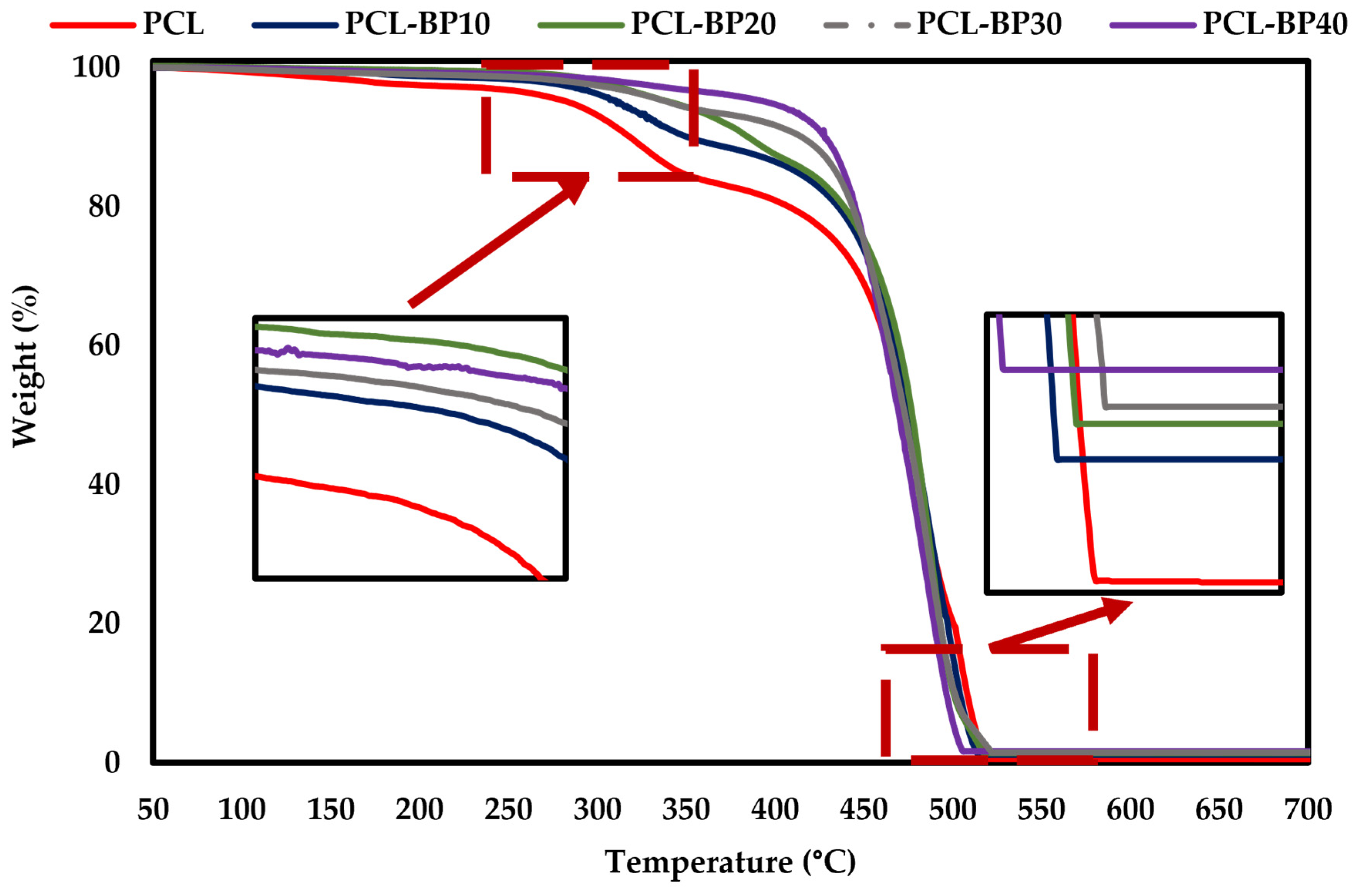

| Composite | PCL (wt·%) | BP (wt·%) |
|---|---|---|
| PCL | 100 | 0 |
| PCL-BP10 | 90 | 10 |
| PCL-BP20 | 80 | 20 |
| PCL-BP30 | 70 | 30 |
| PCL-BP40 | 60 | 40 |
| Composite | Young’s Modulus (MPa) | Ultimate Tensile Strength (MPa) |
|---|---|---|
| PCL | 3.01 | 25.82 |
| PCL-BP10 | 3.17 | 28.67 |
| PCL-BP20 | 3.51 | 31.54 |
| PCL-BP30 | 3.92 | 34.12 |
| PCL-BP40 | 4.19 | 37.27 |
| Sample | Melting Temperature Tm (°C) | Enthalpy of Melting ΔHm (J/g) |
|---|---|---|
| PCL | 55 | 70 |
| PCL-BP10 | 56 | 45 |
| PCL-BP20 | 56 | 40 |
| PCL-BP30 | 56 | 35 |
| PCL-BP40 | 57 | 27 |
Publisher’s Note: MDPI stays neutral with regard to jurisdictional claims in published maps and institutional affiliations. |
© 2022 by the authors. Licensee MDPI, Basel, Switzerland. This article is an open access article distributed under the terms and conditions of the Creative Commons Attribution (CC BY) license (https://creativecommons.org/licenses/by/4.0/).
Share and Cite
Nukala, S.G.; Kong, I.; Patel, V.I.; Kakarla, A.B.; Kong, W.; Buddrick, O. Development of Biodegradable Composites Using Polycaprolactone and Bamboo Powder. Polymers 2022, 14, 4169. https://doi.org/10.3390/polym14194169
Nukala SG, Kong I, Patel VI, Kakarla AB, Kong W, Buddrick O. Development of Biodegradable Composites Using Polycaprolactone and Bamboo Powder. Polymers. 2022; 14(19):4169. https://doi.org/10.3390/polym14194169
Chicago/Turabian StyleNukala, Satya Guha, Ing Kong, Vipulkumar Ishvarbhai Patel, Akesh Babu Kakarla, Wei Kong, and Oliver Buddrick. 2022. "Development of Biodegradable Composites Using Polycaprolactone and Bamboo Powder" Polymers 14, no. 19: 4169. https://doi.org/10.3390/polym14194169








